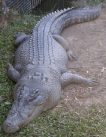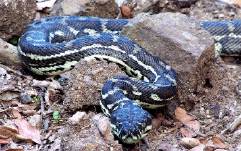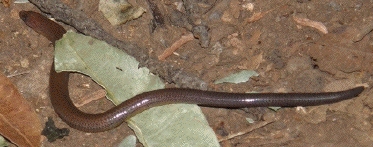 |
|||||||||||||||
|
|||||||||||||||
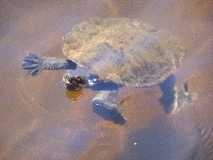 . . |
|
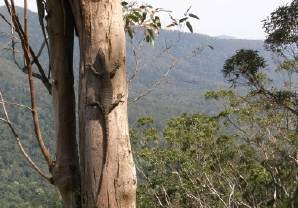 |
|||||||||||||
CrocodilesCrocodilians (including crocodiles, alligators, caimans and gavials) are found throughout the world's tropical regions.We have two crocodile species in Australia:
There are no alligators, gavials or caimans native to Australia. |
|
||||||||||||||
The salt-water crocodile (also called the "saltie") grows to 6m or more, and inhabits rivers, creeks estuaries and sometimes the sea. They live mostly in the downstream, coastal sections of rivets, swamps and estuaries and often venture into the sea. This is the world's ;largest crocodile, found from India through tropical south-east Asia to New Guinea and Australia and some southwest Pacific islands. An extremely powerful, large predator. It has the world's highest jaw pressure: 3,000 pounds per square inch (that's over 210 kilograms per square centimetre). Even a water buffalo (introduced from Asia to northern Australia) can be brought down by a fullgrown saltie. They are better mothers than most reptiles, making a nest during the wet season and staying with the eggs, guarding them until they hatch. |
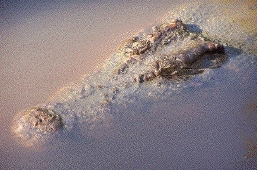 |
||||||||||||||
The freshwater crocodile (also called the "freshie" or the Johnstone River crocodile). It is only found in Australia but there is a similar species in New Guinea. Its snout is much narrower than that of the salt-water croc, and it does not see humans as prey, so tries to stay out of our way rather than stalk us the way the 'saltie' might. They generally live further upstream and do not enter salt-water. They breed in the dry season and are no so protective of their eggs as the salt-water crocodiles. Regrettably they eat the introduced cane toads and have been poisoned by them.  |
|||||||||||||||
Turtles
There
are no true
tortoises
native to Australia, but some of the older
reptiles books refer to
Australian freshwater turtles as tortoises
Marine turtles
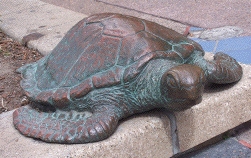 Six
of the
world's seven species of marine turtle inhabit
Australia waters (the only marine turtle in the
world not to do
so is Kemp's Ridley sea turtle
of eastern North America)
Six
of the
world's seven species of marine turtle inhabit
Australia waters (the only marine turtle in the
world not to do
so is Kemp's Ridley sea turtle
of eastern North America)The flatback turtle (Natator depressus) nests nowhere else in the world except the north coast of Australia, but forages also around New Guinea and Indonesia
Other marine turtles in Australian waters are the green turtle, hawksbill, Olive Ridley, loggerhead and leatherback, all of which we share with other warm world regions.
All marine turtles belong to the family Cheloniidae except the leatherback (Dermochelys coriacea; family Dermochelyidae). This turtle has an unusual leathery shell with many small bones embedded as a mosaic within in it.
The photo shows a turtle sculpture at the Gold Coast.
Freshwater turtles (Chelidae and Carettochelyidae)
The odd-looking pig-nosed turtle (Carettochelys
insculpta) is endemic to northern Australia
and southern New
Guinea (i.e it is found nowhere else in the world)
and is the the only
surviving member of an ancient family of turtles
(Carettochelyidae). If conservation threats
continue, even this
one may not survive much longer. It has a pig-like
snout, eats fish,
fruit, insects and a variety of other foods, and
propels itself through
the water with large, flattened fore-legs. All
our other
freshwater turtles are in the family Chelidae, a
family
we share with New Guinea and neigbouring islands and
(from our ancient
Gondwana connections) South America. They turn their
heads sideways
when fitting their necks back into their shells
(turtles of a different
family in Africa also do this). They propel
themselves through the
water with powerful hind limbs.
All
our other
freshwater turtles are in the family Chelidae, a
family
we share with New Guinea and neigbouring islands and
(from our ancient
Gondwana connections) South America. They turn their
heads sideways
when fitting their necks back into their shells
(turtles of a different
family in Africa also do this). They propel
themselves through the
water with powerful hind limbs.They are found in watercourses throughout the mainland, and include:
- Long-necked (or snake-necked) turtles - Chelodina spp. An ancient group, and the world's longest-necked turtles, some with necks as long as their shells
- Short-necked turtles - Emydura
spp., much shorter necks
- Snapping turtles - closely related to Emydura,
including the saw-shelled
turtle of the northeast, with saw-like edge to
their shells
- Western swamp turtle - Pseudemydura. While
the other
three genera are widespread in Australia,
this is a genus, indeed a whole subfamily, with
just one species, found
only in one tiny area in Western Australia
Snakes
NOTE: Some Australian snakes are known to be amongst the most highly venomous in the world (including THE most venomous, the inland taipan), but this does not make them the most dangerous (not that we'd suggest handling them, or not being careful when walking in long grass - there IS danger, but relatively speaking it is over-rated)
Families of snakes in Australia include:
- Front-fanged snakes (Elapidae), both terrestrial and marine (the marine ones - sea snakes and sea kraits - were until recently included in two additional families: Hydrophiidae and )
- Rear-fanged snakes (Colubridae)
- Pythons
(Pythonidae)
- Blind Snakes (Typhlopidae)
- File snakes
(Acrochordidae)
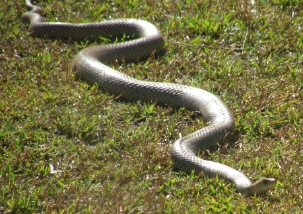 Front-fanged snakes
(elapids)
Front-fanged snakes
(elapids)
This is the largest family of snakes in
Australia, and
includes all our dangerous snakes, but also a lot
that are not
dangerous.Even those which are regarded as dangerous should not cause the kind of paranoia sometimes seen. They know we're too big to eat, so they don't stalk us the way a salt-water crocodile or a shark might, and usually move quickly out of our way if we gently let them know we're coming.
Don't walk through long grass unless you have to, watch the track ahead of you while walking (even at night - some snakes are nocturnal), don't reach into dark spaces such as grain bags, and remember that newly hatched snakes have venom just as potent as adults (just not as much of it). We have lived many years in snake country, walked thoruhg snake country and been very close to sakes and have never been bitten. Still, it does happen to about 3,000 people a year (only one or two of which will usually die). One of the most dangerous is the brown snake shown in the photo - others at the top of the list are taipan, fierce snake (the world's most venomous snake but only found in a small region of the remote outback), tger snake and death 'adder'.
If you or a companion are bitten, don't try to catch the snake (you or someone else may get a worse bite - sometimes a snake's first bite a 'dry' warning bite without injecting venom). Don't wash the venom away - it may be the best way to identify the snake once you reach hospital. Stay as calm and relaxed as possible (to slow the spread of venom through your bloodstream), apply a bandage and splint to immobilize the limb (learn how to do this) further reduce the blood flow (not a tight tourniquet as once recommended) and get to hospital promptly. Visit this site for more details
Death dders are not true adders - they jusy look and behave like them (rather fat and lazy) and are one of the most dangeroius of our snakes, partly becaise f the potency of venom and partly because tey are not as quick to gt out of ur way as other snakes and this more easily trodden on in the long grass.
Red-bellied black snakes are beautiful shiny black creatures with bright red bellies, usually placid, considered dangerous but nowhere near as lethal ss those mentioned above (although its venom produces highly uncomfortable symptoms - you really don't want to try it).
Whipsnakes are very thin, usially quite small snakes whose bites are only very occasionally lethal.
Bandy-bandys are boldly black-and-white- banded snake that usually burrow and feed on blind snakes. When they are above ground and threatened by birds they twist into amazing and alarming loops.
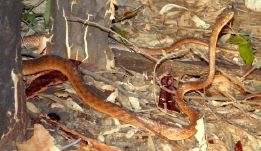 Rear-fanged
snakes (colubrids)
Rear-fanged
snakes (colubrids)
This is the largest snake family in the rest of the world but Australia has only a few species.
They have fangs situated well back in the mouth so generaly unable to give a serious bite to large animals such as humans (unless they somehow poke their fingers into their mouths). There are some large and dangerous ones in other countries.
Brown treesnakes are venomous but becuase of being rear-fanged are not considered dangerous to humans. Green treesnakes and keelbacks are not venomous. Keelbacks are one of the few species that can eat cane toads without being lethally poisoned by them.
Pythons
The best-known Australian python is the carpet snake (pictured to right), found in a variety of habitats from rainforest to semi-arid woodlands, across the northern and eastern parts of Australia, as well as southwestern Australia and also New Guinea. It is also one of the most popular snakes in captivity, and grows to about 3 metres.
Blind Snakes
These harmless little fellows spend most of their time below the surface of the ground, seeking termites and ants to feed on. They in turn are eaten by bandy-bandy snakes. At first sight they look a bit like a large earthworm. The family is found in most of the world's warmer regions.File snakes
A family with just three aquatic species, from south-east Asia to far north Australia. Australia has just one species.Lizards
There are 5 families of lizards in Australia:- skinks (Scincidae),
- dragons (Agamidae),
- monitors (Varanidae - locally called 'goannas'),
- geckos (Gekkonidae) and
- flap-footed lizards (Pygopodidae - also called legless lizards or snake-lizards, found only in Australia and New Guinea)
We do NOT have iguanas, although some of our dragons look a bit like them (and are in fact a related family), and some people erroneously assume 'goanna' means 'iguana'.
Skinks
Australia has more skinks than any other country, and there are more skink species in Australia than any other kind of lizard.They are usually smooth-bodied (exceptions include shingleback and spiny skink).
The scales on their heads are in a mirror-image pattern (hard to see on the little skinks that scamper up walls or dive under the lead litter as walkers approach in a forest, but easier to see on the large skinks such as the blue-tongue) - they share this bilateral symmetry with flap-footed lizards.
Our largest skink is the land mullet, looking like a big black shiny fish out of water, found in the rainforests.
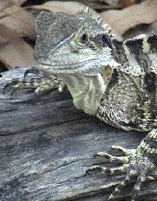 Dragons
Dragons
Bumpy, spiny or crested lizards in Australia
are usually
dragons
(although a few skinks are 'bumpy' - especially the
shingleback)This is our second largest family of lizards.
A few examples are:
- The famous frill-necked lizard is a dragon, and like many dragons often runs on two legs
- The extraordinary thorny devil, with its bizarre appearance and excellent adaptation to desert life
- The bearded dragon, well-camouflaged but
common in
many areas (see photo below of two having
a territorial dispute)
- The eastern water dragon is often seen in eastern coastal areas, including public parks and along the edges of rivers and creeks, which it will often plunge into if disturbed

Monitors (goannas)
These are our largest lizards. The Komodo dragon of Indonesia is monitor, not a dragon, and Australia used to have a monitor even larger, still here when Aboriginals first arrived.Monitors have forked tongues, like snakes, and use the the same way, flicking them in and out to smell what is nearby.
The most commonly seen one is th lace monitor (as shown in the photo), sometimes wandering around picnic tables in search of scraps.
Geckos
Geckos are small nocturnal lizards found in all the world's warmer regions, using remarkable toes with millions of tiny hairlike structures to scurry up walls and even across ceilings in pursuit of insects. They have no eyelids, so sometimes lick their eyes to clean them.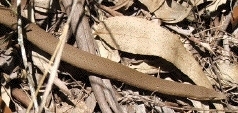 Flap-footed
lizards
Flap-footed
lizards
This is an exclusively Australian/ New Guinea
family of
lizards (or subfamily 0 there is talk of
moving them into the
gecko family). They are sometimes mistaken for snakes, but remnants of hind legs can still be seen as small flaps, they have external ear openings, and their tongues are not forked, although not all of those characteristics can readily be seen in some species. There are also legless skinks, but a perusal of the possible spices of flap-footed lizard in any locality should soon distinguish them.
Books and other information
The most comprehensive book for identification of reptiles and amphibians in Australia is Cogger, H. Reptiles & Amphibians of Australia, with periodic updates but the latest edition (2000) is out of print and hard to find
We now also have 'A complete guide to reptiles of Australia', second edition by Steve Wilson and Gerry Swan (2008)
A journal for herpetologists and reptile keepers on Australia is Reptiles Australia Magazine
Check out this site for turtles
Here's an extensive list of references on snake venom and snakebites
Australian Museum reptiles page
Also see the Australian Herpetology Society
